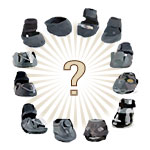By Les Sellnow
The aging process brings with it some inevitable changes in horses. As is often the case with humans, the horse’s joints begin to stiffen as he gets older. Eventually, many horses are unable to meet the same performance standards that they did when younger, and we begin to wonder what we can do to help.
There are a great many horses that fit into this category. Some veterinarians have estimated that about 20% of the horse population is older than 15 years of age. It is believed that one year of a horse’s life is equal to an average of three years of a human life. This would mean that a 15-year-old horse could be compared to a 45-year-old person.
In both cases, individuals of that age can remain healthy and lead useful lives, but issues like proper nutrition and attention to the joints are required when such needs surface. In some cases joint supplements might be called for, and if that doesn’t get the job done, joint injection might be a treatment of choice. We’ll concentrate on supplements in this article on older horses, leaving a discussion of joint injections for the actively competing horse.
Shock Absorption
One of the problems we face with our equine companions is that there are a lot of joints to deal with, and they have been subjected to a variety of stresses and pressures during the horse’s lifetime of activity. These sometimes fragile joints have been given the task of absorbing shock, allowing for nearly frictionless movement and bearing the weight of a body that often is in the 1,200-pound to 1,500-pound range.
It is a given that the more arduous the activity, the more stress and pressure on the joints.
If the horse is gifted with good conformation, it often has been able to handle these stresses and still remain sound and strong. However, if the reverse is true, the wear and tear on joints has been exacerbated. The problem is further complicated by the fact that there are 205 bones in the horse’s skeleton. Twenty of these bones are in each foreleg and 20 in each rear leg, for a grand total of 80 bones in the four equine legs. Each is connected or aligned with one or more other bones, allowing the horse to lift, bend, and flex its legs. This ability permits the horse to travel across the ground, absorbing concussion along the way.
The part of the horse’s anatomy to strike the ground first in a given stride is the hoof. It starts the concussion absorption process while, at the same time, protecting the inner bones, joints, blood vessels, and nerves of the foot. Generally speaking, as a horse ages its hoof remains strong if it was properly conformed at birth and well-cared-for during the horse’s lifetime.
The problem with hooves, more often than not as the horse ages, involves the care, or lack of it, that they receive. Often one of the first aspects of good care that is neglected when a horse reaches its retirement years is its feet. It is important to remember that a horse requires ongoing hoof care even when it is no longer working on a daily basis.
Some older horses might require regular shoeing as protection for the foot or to relieve pressure on soft tissues; many do better being barefoot.
However, the aging process will very likely take a heavier toll on the joints than on the feet.
Types of Joints
The spot where one bone joins another is the joint, and there are three basic types. They are:
- Synovial joints: These are the movable joints and the ones that tend to be at risk during the aging process. An example of a synovial joint is the knee, which actually contains three joints and multiple bones. In a manner of speaking the synovial joints are the horse’s ball bearings. A synovial joint consists of two or more bone ends covered by articular cartilage. The cartilage within the joint is smooth and resilient, allowing for nearly frictionless movement. Each joint capsule also contains an inner lining called the synovial membrane, which secretes synovial fluid to lubricate the joints.
- Cartilaginous joints: These joints are slightly movable or immovable, depending on the bones involved. Cartilaginous joints are united by fibrocartilage, hyaline cartilage, or both. The connective tissues between vertebrae comprise a cartilaginous joint.
- Fibrous joints: These basically are immovable joints where the bones are bound by fibrous tissue that ossifies as the horse matures. An example is joints within the equine skull.
We must point out that most of the problems that develop in the joints of older horses involve synovial joints. The reason is quite obvious: they are the ones that sustain the most friction and stress and are called upon to absorb the most concussion.
EasyCare Suggests the Use of Boots When Taking the Older Horse Barefoot
To help out your older equine, make sure to include protective horse boots in these golden years. Taking them barefoot is a great step and providing them with EasyCare horse boots and Comfort Pads can make the barefoot process move along better for them. The use of boots and pads will absorb that concussion and may make the need for expensive joint supplements not a necessary thing. Seek the help of a trimmer or natural hoof care specialist to assist you in your decision process. Then let us here at EasyCare assist you with finding the right boot style for your senior equine companion. They have given you their best, so now you can give them the best in hoof care products.
Check out our website here and give us a call for more information at 800-447-8836.

Nancy Fredrick

EasyCare Office Manager- Retired 2017




